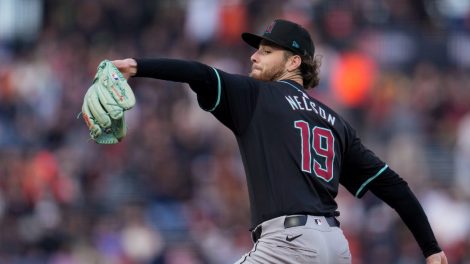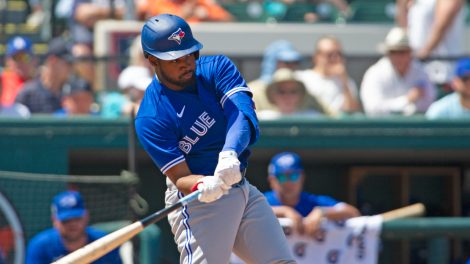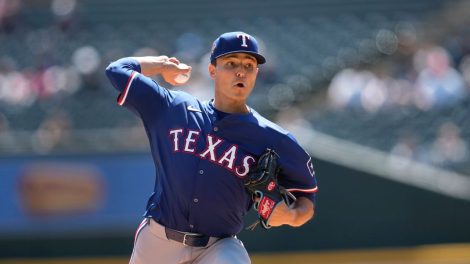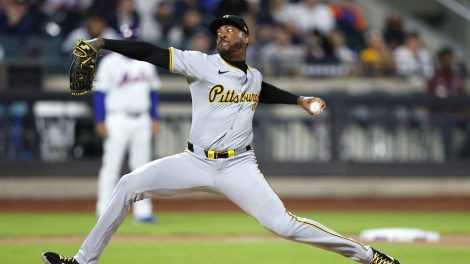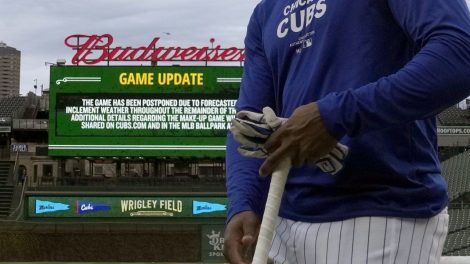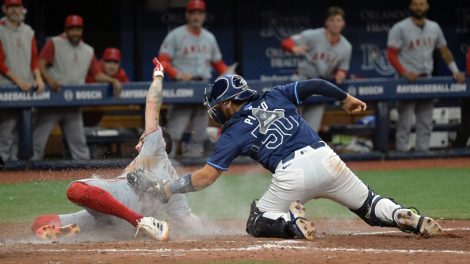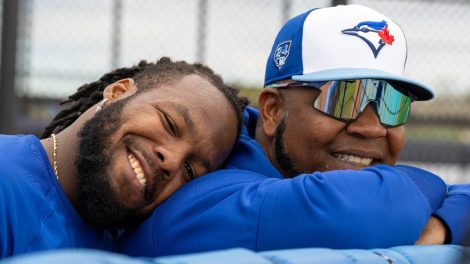TORONTO – There is an element of uncertainty with every call-up from the minor leagues, no matter how talented the player, no matter the level of dominance on the way up. The volatility of performance and difficulty in transition only increases the younger and less experienced a player is, all of which Jim Beattie considered in September 1996 when as general manager of the Montreal Expos, he brought up Vladimir Guerrero to the majors straight from double-A.
At the time, Guerrero was just 21 years old with 1,179 plate appearances in 285 minor-league games under his belt.
"We knew what we were doing, right? Of course everyone else in baseball would have done the same thing," Beattie, now a pro scout for the Toronto Blue Jays, says with a laugh. "Looking back on it, the Montreal Expos brought up a lot of young players and got them into the big leagues early in their careers, and a major part of the success and the reason why they were able to do that is, especially in Vlad’s case, was (former manager) Felipe Alou.
"Felipe was very good at putting young players in situations where they could succeed. There were old managers who’d say, ‘Rookies get managers fired.’ Felipe never felt that way, partially because he understood what was going on in Montreal. For Vlad, having Felipe was a combination of things, and I remember Felipe saying, ‘Don’t worry, this kid will be fine. We’ll make sure he’s going to be OK.’"
Save for rehab assignments and a last-gasp 12 games in the Blue Jays system in 2012, Guerrero never touched the minors again during a 16-year career that this week earned him a place in the Hall of Fame.
Beattie, in his first year as Expos GM following the resignation of Kevin Malone after the 2005 season, operated under the financial constraints that continually submarined the franchise’s progress and forced it to push young, inexpensive talent up quickly.
Guerrero certainly deserved consideration after bagging Eastern League MVP honours at double-A Harrisburg, where he batted .360/.438/.612 in 118 games. Everyone noticed the way he swung at everything from his eyeballs to his shoelaces, but a death-knell to most careers for him was no hindrance.
"He didn’t miss the ball much, even when the ball was out of the zone and he was able to square up, even bad pitches," says Beattie. "I remember going down to see him play in double-A and marvelling at the power that was generated by his body. He had a fairly violent swing and usually guys who have that type of swing don’t square it up as well. But he could do everything wrong, jump out, get ahead of the pitch, but he always kept his hands back and he could use them and get the bat to the ball and square it up. He had strength in those hands and those arms that made him very special."
[snippet id=3305549]
The point is well made, as Guerrero struck out in only 10.9 per cent of his 9,059 big-league plate appearances, topping out at 95 in 1998, when he was just 23. That was the year he really emerged as a dominant force, batting .324/.371/.589 with 38 home runs, 37 doubles and seven triples.
"He was a true five-tool player, but when he first came up he was like this wild colt. He had to learn how he could incorporate those tools into the game itself," says Beattie. "He’d catch a fly ball at the warning track thinking he’d throw the guy out at the plate on a sacrifice fly. He damn well could do it if he had the right runner, but there were times it would go all the way home on the fly, and at some point you’d have to say, ‘OK, Vladdy, there are guys at first and third, you want to hit the cut-off man so the guy doesn’t go to second and keep the double play in order.’ That type of stuff.
"But he’d do these things where you’d scratch your head thinking he couldn’t do it, and he would do it, he would throw a guy out at the plate with that rocket arm. He could make the crowd ooh and ah in every phase of the game. He was just a special athlete."
Beattie watched Guerrero grow and develop until he resigned as Expos GM after the 2001 season. In February 2010, he joined the Blue Jays as a professional scout and these days, he occasionally experiences an odd sort of déjà vu when he watches Guerrero’s gilt-edged prospect son, Vladimir Jr., play in the club’s farm system.
"When I’ve seen him, I’ve thought, well, that’s not Vlad’s body, that’s a different body," says Beattie. "But there’s something special in those hands in the same way as his dad."
Another difference is that the son is a far more disciplined hitter than his father and rarely chases out of the zone. Amid the homer/strikeout revolution in recent years, Guerrero Jr., has 109 walks versus only 97 strikeouts in 803 plate appearances over 181 minor-league games.
And he won’t be 19 until March 16.
"That’s an evolution – when Vlad came up, there wasn’t any of that, there was no work your walks," says Beattie. "The thing about Vlad is if you told him to do something, he could do it but in his mind, he said, ‘Why do I have to wait for a walk or work a walk if I know I can hit a ball and get a double or a triple out of it.’ He wasn’t going to be the home run/strikeout type of guy that could be popular these days. He would have adjusted, like many great players, they would have changed their games with the information available to be more successful. That’s what his son has done.
"It must be exciting for Vlad to watch this, and I hope at some point I get to see Vlad when he comes over to watch his son."
[relatedlinks]


